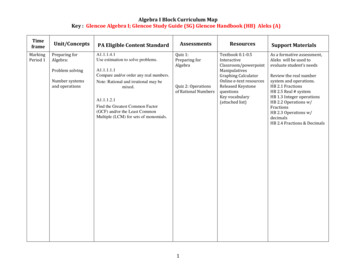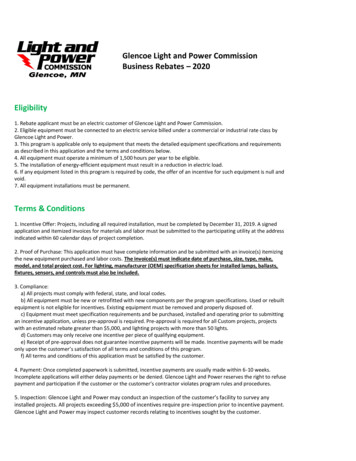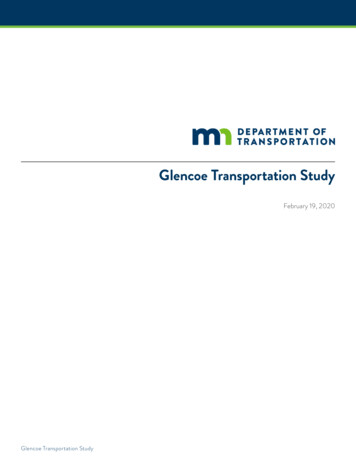
Transcription
Sampleotsnoeent fi.esl imagnaERresrepPLaysalwSAMrdaptechPersonal FinanceGlencoe
GlencoePersonal Finance
Notice: Information on featured companies, organizations, and theirproducts and services is included for educational purposes only anddoes not present or imply endorsement of the Personal Finance program.MHEonline.comCopyright 2015 McGraw-Hill EducationAll rights reserved. No part of this publication may bereproduced or distributed in any form or by any means, orstored in a database or retrieval system, without the priorwritten consent of McGraw-Hill Education, including, but notlimited to, network storage or transmission, or broadcast fordistance learning.Send all inquiries to:McGraw-Hill Education8787 Orion PlaceColumbus, OH 43240ISBN: 978-0-02-138608-6MHID: 0-02-138608-0(Student Edition)(Student Edition)Printed in the United States of America.1 2 3 4 5 6 7 8 9 XXX 22 21 20 19 18 17 16 15i 0001 FM 138608.indd ii1/10/15 7:12 PM
About the AuthorsJack R. KapoorJack Kapoor is a professor of business and economics in the Business and Technology Divisionof the College of DuPage, Glen Ellyn, Illinois, where he has taught business and economics since1969. He received his BA and MS from San Francisco State College and his EdD from NorthernIllinois University. He previously taught at Illinois Institute of Technology’s Stuart School ofManagement, San Francisco State University’s School of World Business, and other colleges.Professor Kapoor was awarded the Business and Technology Division’s Outstanding ProfessorAward for 1999-2000. He served as an assistant national bank examiner for the U.S. TreasuryDepartment and has been an international trade consultant to Bolting Manufacturing Co., Ltd.,Bombay, India. Dr. Kapoor has been an author, content consultant and developer for books,television series, and audio courses, and has studied business practices in capitalist, socialist, andcommunist countries.Les R. DlabayLes Dlabay is a professor of business at Lake Forest College, Lake Forest, Illinois. Sharing resourceswith the less fortunate is an ongoing financial goal of his. Through child sponsorship programs,world hunger organizations and community service activities, he believes the extensive wealthin our society should be used to help others. In addition to writing several textbooks, Dr. Dlabayteaches various international business courses. His “hobbies” include collecting cereal packagesfrom over 100 countries and paper currency from 200 countries, which are used to teach abouteconomic, cultural, and political aspects of foreign business environments. Professor Dlabayalso uses many field research activities with his students, conducting interviews, surveys, andobservations of business activities.Robert J. HughesBob Hughes, professor of business at Dallas County Community Colleges, believes two words,Financial Literacy!, can literally change people’s lives. Whether you want to be rich or just managethe money you have, the ability to analyze financial decisions and gather financial information areskills that can always be improved upon. In addition to writing several textbooks, Dr. Hughes hastaught personal finance, introduction to business, business math, small business management,small business finance, and accounting since 1972. He also served as a content consultant fortwo popular national television series, and is the lead author for a business math project utilizingcomputer-assisted instruction funded by the ALEKS Corporation. He received his BBA fromSouthern Nazarene University and his MBA and EdD from the University of North Texas. Hishobbies include writing, investing, collecting French antiques, art, and travel.Authorsi 0001 FM 895839.inddiiiiii11/23/109:11 AM
Contributors and ReviewersDustin DayleyHurricane High SchoolHurricane, UTMelinda SloanMcGavock High SchoolMount Juliet, TNSusie WrightWalnut Ridge High SchoolColumbus, OHTraquel DayleyFinancial & EconomicEducation ConsultantHurricane, UTRhonda BradbyBusiness Education TeacherSurry County High SchoolDendron, VASteven GearhartCTE Business TeacherJohn F. Kennedy High SchoolSan Antonio, TXKathy Kagay, retiredMaysville High SchoolMaysville, MOSally MartinBrentsville District High SchoolNokesville, VAPatty WambleCape Central High SchoolCape Girardeau, MissouriAriane Biba S. KavassEconomics/Personal FinanceTeacherSouthwind High SchoolMemphis, TNPaul JussilaSouth Windsor High SchoolSouth Windsor, CTGlen ZipfelChristian Brothers High SchoolSt. Louis, MissouriMike KellyHazelwood East High SchoolSt. Louis, MOJeff NoyesMinnetonka High SchoolMinnetonka, MinnesotaJason LeeOlympia High SchoolOrlando, FLMark Van HoyHazelwood West High SchoolHazelwood, MissouriNatalie SchaublinWesterville North High SchoolWesterville, OHAlana EatonKennard-Dale High SchoolFawn Grove, PAKen SchnitzerMontclair High SchoolMontclair, NJTracy KellyCoolidge High SchoolCoolidge, AZMindy RobisonMathematics TeacherMidvale Middle School,Canyons School DistrictMidvale, UTDeborah CrosbyBusiness InstructorGlencliff High SchoolNashville, TNTeresa HarmonCrystal City High SchoolCrystal City, MOivReviewersi 0001 FM 895839.indd iv2/25/11 4:22 PM
Table of ContentsUnit 1Economics and Personal FinanceChapter 1 The Fundamentals of EconomicsChapter Reading GuideSection 1 What Is Economics?Section 2 The U.S. Economic SystemVisual SummaryChapter 1 Review and AssessmentYour Financial Portfolio246719262729Chapter 2 Economics and the Global Economy30Chapter Reading Guide323343525355Section 1 The Economy and the GovernmentSection 2 The Economy and Global TradeVisual SummaryChapter 2 Review and AssessmentYour Financial PortfolioUnderstanding Globallobal Trade56DAJ/Getty ImagesUnit 1 ProjectTable of Contentsi 0001 FM 138608.indd vv1/17/15 10:44 AM
Table of ContentsUnit 2 Planning Personal FinancesChapter 3 Personal Financial PlanningChapter Reading GuideSection 1 Financial Decisions and GoalsSection 2 Opportunity Costs and StrategiesVisual SummaryChapter 3 Review and AssessmentYour Financial PortfolioChapter 4 Finances and Career PlanningChapter Reading GuideSection 1 Planning Your CareerSection 2 Employment and Career DevelopmentVisual SummaryChapter 4 Review and AssessmentYour Financial PortfolioChapter 5 Money Management StrategyChapter Reading GuideSection 1 Organizing Financial RecordsSection 2 Personal Financial StatementsSection 3 Budgeting for Financial GoalsVisual SummaryChapter 5 Review and AssessmentYour Financial PortfolioChapter 6 Consumer Purchasing and ProtectionChapter Reading GuideSection 1 Consumer PurchasingSection 2 Resolving Consumer 1126135144145147148150151169176177179180Fuse/Getty ImagesVisual SummaryChapter 6 Review and AssessmentYour Financial PortfolioUnit 2 Project Planning for Financial and Career Success58viTable of Contentsi 0001 FM 895839.indd vi12/30/14 1:17 AM
Table of Contents182Unit 3 Banking and CreditChapter 7 BankingChapter Reading GuideSection 1 Financial Services and InstitutionsSection 2 Savings Plans and Payment MethodsVisual SummaryChapter 7 Review and AssessmentYour Financial PortfolioChapter 8 Consumer CreditChapter Reading GuideSection 1Section 2Section 3Section 4What Is Consumer Credit?The Costs and Methods of Obtaining CreditProtecting Your CreditManaging Your DebtsVisual SummaryChapter 8 Review and AssessmentYour Financial PortfolioChapter 9 The Finances of HousingChapter Reading GuideSection 1 Housing OptionsSection 2 Renting a ResidenceSection 3 Buying and Selling a HomeVisual SummaryChapter 9 Review and AssessmentYour Financial PortfolioUnit 3 Project Preparing for Home 6267269270272273277284304305307308LWA/Dann Tardif/Getty Images[DESIGN: Leave room for2nd use photo: CXX-XXP]Table of Contentsi 0001 FM 138608.indd viivii1/17/15 10:47 AM
Table of ContentsUnit 4 Investing Financial ResourcesChapter 10 Saving and InvestingChapter Reading GuideSection 1 Preparing for a Savings or Investment ProgramSection 2 Savings and Investment OptionsSection 3 Reducing Risk and Sources of InformationVisual SummaryChapter 10 Review and AssessmentYour Financial PortfolioChapter 11 StocksChapter Reading GuideSection 1 Common and Preferred StocksSection 2 Evaluating StocksSection 3 Buying and Selling StocksVisual SummaryChapter 11 Review and AssessmentYour Financial PortfolioChapter 12 Bonds and Mutual FundsChapter Reading GuideSection 1Section 2Section 3Section 4Corporate and Government BondsInvesting in BondsMutual FundsInvesting in Mutual FundsVisual SummaryChapter 12 Review and AssessmentYour Financial PortfolioChapter 13 Real Estate and Other InvestmentsChapter Reading GuideSection 1 Real Estate InvestmentSection 2 Precious Metals, Gems, and CollectiblesVisual SummaryChapter 13 Review and AssessmentYour Financial PortfolioUnit 4 Project Developing an Investment 6457459460Table of Contentsi 0001 FM 895839.inddviii11/30/103:10 PM
Table of ContentsUnit 5 Protecting Your Finances462Chapter 14 Planning Your Tax 4615617618620644650662Chapter Reading GuideSection 1 Income Tax FundamentalsSection 2 Preparing an Income Tax ReturnSection 3 Tax Assistance and StrategiesVisual SummaryChapter 14 Review and AssessmentYour Financial PortfolioChapter 15 Home and Motor Vehicle InsuranceChapter Reading GuideSection 1 Insurance and Risk ManagementSection 2 Home and Property InsuranceSection 3 Motor Vehicle InsuranceVisual SummaryChapter 15 Review and AssessmentYour Financial PortfolioChapter 16 Health, Disability, and Life InsuranceChapter Reading GuideSection 1Section 2Section 3Section 4Health Insurance and Financial PlanningPrivate and Government PlansDisability InsuranceLife InsuranceVisual SummaryChapter 16 Review and AssessmentYour Financial PortfolioChapter 17 Retirement and Estate PlanningChapter Reading GuideSection 1 Retirement PlanningSection 2 Planning Retirement IncomeSection 3 Estate Planning and TaxesVisual SummaryChapter 17 Review and AssessmentYour Financial PortfolioUnit 5 Project Planning for RetirementMath Skills BuilderCareer Skills HandbookGlossaryIndexTable of Contentsi 0001 FM 895839.indd ixix12/30/14 1:17 AM
Features Table of ContentsReal-World ApplicationsCan you create and develop a budget? Do you know how to develop a financial career goal? TheseUnit Project features will help you get involved in the world of personal finance.Unit ProjectUnit 1Unit 2Unit 3Unit 4Unit 556180308460618Understanding Global TradePlanning for Financial and Career SuccessPreparing for Home OwnershipDeveloping an Investment PlanPlanning for Retirement Discovery ProjectTeaching Financial LiteracyDevelop a Financial PlanCreating a Purchase PlanBuilding a Career PlanBuilding a BudgetSavvy ShoppingComparing OptionsBuilding Good CreditYour First Apartment5316189119149185223271Planning for the FutureVirtual Stock MarketInterpreting a ProspectusSupplementing Your PortfolioComparing Tax RatesExplore Insurance OptionsExploring Health Insurance CoveragesPlanning for Retirement313351387435465501537575College and Career ReadinessxCivicCii LiteracyLit23MediaM di LiteracyLit214CommunicationCi ti441Global 8Information Literacy332Health Literacy543Teamwork137Problem Solving374Decision Making602Innovation160Interpersonal Skills416Table of Contentsi 0001 FM 895839.inddx12/2/1011:27 AM
Features Table of ContentsLife Skills You Can UseThese features allow you to learn about many different finance-related careers as well asfinance-related skills and information you will need to successfully meet your financial goals.Careers That Count!Legislative AssistantBudget AnalystPersonal BankerCustomer Service RepresentativeFinancial AccountantRetail Sales SpecialistTellerCredit AnalystReal Estate Agent12466498128173188255286To the Highest BidderGlobalization and the InternetUsing SoftwareJob Hunting OnlineProtecting Financial RecordsBig Mac IndexFingerprints for CashPhishingVirtual Tour SoftwareFrom Ticker Tape to Smart PhonesE-tradingSecurity in an Uncertain TimeCollectiblesE-commerce TaxReducing Car Insurance CostsTransferable SkillsCalculate Your 41591316378413442472515554588Investment AnalystStockbrokerCertified Financial PlannerCommercial Property ManagerTax PreparerInsurance Claims AdjusterInsurance AgentEstate PlannerDiversifyStrong Dollar Versus a Weak DollarPay Yourself FirstCareer CenterPay or Save?Impulse BuyingApplying for an AccountOne Is EnoughOn Your OwnA Dollar a DayListen UpSavings Mind-SetCollectible GiftsTry LayawayStudent DiscountsFitness FunTime to 9Table of Contentsi 0001 FM 895839.inddxixi11/30/103:10 PM
Features Table of ContentsImprove Your Financial SkillsDo you know how a deficit can affect your own personal finances? Can you create a personalbalance sheet? These features will help you improve your financial skills.Economics and YouAdam SmithEconomic ActivityOpportunity CostA Nation’s ResourcesBalance of TradeConsumer IncentivesThe Federal Reserve SystemInterest RatesMoney and InflationGO FIGURE223682105122152205228296Economic InstitutionsEconomic GrowthBondsMarket PricingFact of ScarcityCompetitionYour Tax DollarsGross Domestic Product341365405452494517564596Total ReturnsEarning per sharePrice-Earnings RatioA Bond’s Annual InterestApproximate Market Value of a BondDollar Amount of Return on a T-BillRate of Return on a T-BillCurrent Yield of a Bond InvestmentNet Asset ValueCapital Gain per SharePercentage of Asset Growth Withdrawel1040EZ Tax Due367368369380396399400408412423428482A Stock Confirmation ReportA Mutual Fund Account StatementCounty Real Estate ValuationForm W-2An Auto Insurance DeclarationA Life Insurance Policy StatementA Projected Retirement Budget Worksheet357421439469507567582MathematicsAnnual Interest77The Future Value of a Single Deposit78Net Worth130Net Cash Flow132Unit Pricing167Interest Compounded Monthly207Rate of Return208Debt Payments-to-Income Ratio (DPR)235Simple Interest on a Loan237Inflation Rate and Investments326Bond’s Market Price327, 328Current Yield of a Stock Investment366Document DetectiveA Monthly Budget WorksheetAn IRS Form W-4A Personal Balance SheetA WarrantyA Bank StatementA Credit Card StatementCalculating a Mortgage PaymentA Savings Goals Worksheetxii6699139159193261289321Table of Contentsi 0001 FM 895839.inddxii11/23/109:12 AM
Features Table of ContentsFinance in the Real WorldIt is important to know how finance actually works in United States and global economies. Thesefeatures will show you how financial topics affect real-world companies and individuals, and howfinancial topics affect people in different parts of the world.ASKRegulation in a Market EconomyGovernment Policies and EconomicsThe Money PlanPlanning for LifeUsing a BudgetComparison ShoppingSavings AccountCredit PaymentsHousing Options5316189119149185223271InvestmentsStock CertificatesMutual FundsCollectingElectronic TaxesInsurance RatesHealth Care CostsWill Power31335138743546550153757517388097141Ethiopia: Investing at HomeBrazil: Trading on EthanolRussia: First Bond Issued in 12 YearsAustralia: OpalsSaudi Arabia: Zakat TaxesMexico: Green AngelsTaiwan: Smart Card SystemCosta Rica: Popular Destinationfor Expatriates325377391445480526551Around the World163199238293604Tanya Constantine/Getty ImagesDenmark: High Income TaxRwanda: One Laptop per ChildMalaysia: Licensed Financial PlannersIsrael: Compulsory Military ServiceKenya: Texting MoneyCanada: Financial ConsumerAgency of CanadaIndia: Microloans for ElectricityJapan: Cash-Driven EconomyItaly: Stable Approach to Home OwnershipTable of Contentsi 0001 FM 138608.indd 111/17/15 10:50 AM
UNIT2Planning PersonalFinancesYour skills, interests, and strengths can leadyou to a rewarding career that will help youachieve your financial goals. What factorsmight influence your career path?58altrendo images/Getty ImagesVisual LiteracyUNIT 2Planning Personal Finances0058 0059 PF S U02 UO 138608.indd 5812/29/14 7:21 PM
In Your WorldDiscover a CareerHave you ever wondered why some people find great satisfactionin their work while others only do the minimum required? As withother personal decisions, choosing a career requires planning. Whenplanning for a career, identify your interests and strengths and thinkabout how they apply to various career fields. Use this informationalong with your research of job industries to help you choose a futurecareer path. Which careers or career fields do you feel align with yourstrengths and interests?Career Planning Career planning often begins at a very young age.Many children dream of being a firefighter or a pilot, for example, onlyto change their mind a few years later. What were your first thoughtson a career? Did you change your mind? Explain why or why not.Economics and YouJob GrowthHave you ever traded baseball cards or lunches with someone?Trade with foreign countries can also be mutually beneficial,even generating jobs in the United States. For example, theUnited States imports automobiles from Japan. Japan then usesthe income to purchase cotton and airplanes from the UnitedStates. Jobs are created to produce the cotton and airplanes andto market and sell the automobiles. Consider a popular product.What industries are involved in the making and selling of thatproduct? How could this impact job growth?connectED.mcgraw-hill.comActivity Download an Economics and You Worksheet Activity.590058 0059 PF S U02 UO 138608.indd 5912/29/14 7:22 PM
CHAPTER3Personal FinancialPlanningVisual LiteracyCaia Images/Glow ImagesEstablishing a plan for how you spend yourmoney can help you make wise purchases.What factors help you decide what to buy andwhat not to buy?60UNIT 2Planning Personal Finances0060 0061 PF S C03 CO 138608.indd 6012/29/14 7:27 PM
Discovery Project Creating a Purchase PlanFinancial planning can lead tofinancial independence andsecurity.Key QuestionWhy is it important to have a plan before making afinancial decision?ASKProject GoalYou have a large family, but only one computer foreveryone to use. It can be challenging to coordinatecomputer time with the other members of yourhousehold, so you have decided that it is time to getyour own computer. Your family agrees, so they give you 50.00 to help out. You have about 400.00 saved fromyour part-time job. The computer you want is a laptopthat has been advertised on television at a local storefor 775.00, but your friend bought the same modeldirectly from the manufacturer for 725.00. Develop astep-by-step financial plan that identifies what you mustaccomplish to buy the laptop in time for a major researchproject, which is due at the end of the school year.Ask Yourself. How much of your current savings can you reasonablycontribute to the laptop? What other expenses will you have in the time frame? What risks may be associated with the purchase, andwill the benefits outweigh the risks? How much more can you save by the end of the year? What can you do to find the best price on the laptop? What steps in your plan ensure that you will accuratelytrack your spending and saving?Tanya Constantine/Getty ImagesManage Goals and TimeThe Money PlanQ I am a high school student. I doAnot have money for investmentsor buying property. So whatdifference does it make how Ispend my money now?You will not always be a student.Learning to save and use moneywisely now will help you knowhow to achieve financial securityin the future. While you are inhigh school, financial planningcan help you decide how tospend, save, and invest yourmoney for special purchases oractivities that matter to you. Youmay even be able to buy stock!Writing ActivityMake a list of five or moreitems you would like to purchase.Write a short report comparing thecosts and benefits of purchasingeach item. How much time do youthink it will take to save the moneyfor each? How can this activity beconsidered financial planning?How can creating a written plan for a significant purchase,such as a laptop, help you manage your time and meet yourfinancial goals?connectED.mcgraw-hill.comEvaluate Download an assessment rubric.Chapter 3Personal Financial Planning0060 0061 PF S C03 CO 138608.indd 61611/17/15 10:59 AM
Reading GuideCHAPTER 3Before You ReadThe Essential Question Why is it important to learn now how toplan for your financial future?Main IdeaThe financial planning process can help you reach yourfinancial goals.Content VocabularyAcademic Vocabulary personal financial planning goals values liquidity service good consumer interest time value of money principal future value annuity present valueYou will see these words in yourreading and on your tests. estimate consume weigh accumulateGraphic OrganizerBefore you read this chapter, create a study organizer like the onebelow. As you read, identify four guidelines for setting yourfinancial goals.Setting Your Financial GoalsconnectED.mcgraw-hill.com62Download this graphic organizer.UNIT 2Planning Personal Finances0062 PF S C03 RG 138608.indd 6212/30/14 7:27 PM
Financial Decisions and GoalsSECTION 1Personal Financial DecisionsWhat are the benefits of financial planning?What is personal finance? It is everything in your life that involvesmoney. Personal financial planning is arranging to spend, save, andinvest money to live comfortably, have financial security, and achievegoals. Everyone has different financial goals. Goals are the things youwant to accomplish. For example, getting a college education, buying acar, and starting a business are goals. Planning your personal financesis important because it will help you to reach your goals, no matterwhat they are. It is up to you to make and follow a financial plan.Some of the benefits of planning are: Increased effectiveness in obtaining, using, and protecting yourfinancial resources throughout your lifeIncreased control of your finances by avoiding too much debt,bankruptcy, and dependence on othersImproved personal relationships gained from well-planned andwell-communicated financial decisionsA sense of freedom from financial worries gained from looking tothe future, anticipating expenses, and achieving personaleconomic goalsSection Objectives Define personal financialplanning. List the six steps of financialplanning. Identify factors that affectpersonal financial decisions.As You ReadRelate What are yourfinancial goals? Which goalsare needs and which goalsare wants?We all make hundreds of decisions each day. Most of these decisionsare quite simple and have few consequences. However, some arecomplex and have long-term effects on our personal and financialsituations. While everyone makes decisions, few people considerhow to make better decisions. The financial planning process can beviewed as a six-step process that can be adapted to any life situation.STEP 1Determine Your Current Financial SituationTo figure out your current financial situation, make a list of items thatrelate to your finances: SavingsMonthly income (job earnings, allowance, gifts, and interest onbank accounts)Monthly expenses (money you spend)Debts (money you owe to others)A good way to estimate, or make an approximate calculation of,your expenses is to keep a careful record of everything you buy forone month. You can use a small notebook or computer to track yourexpenses. When you have determined your financial situation, youwill be able to start planning.Chapter 3Personal Financial Planning0063 0075 C03 S01 895839.indd636311/19/108:07 AM
Careers That Count!Jason Coupland Personal BankerEXPLORE CAREERSAs a personal banker for a national bank, I develop, manage, and buildcustomer relationships. My clients range from high school studentsopening their first accounts, to businesspeople seeking precisefinancial products and services. Throughout the week, I oversee thefinancial operational activities for personal accounts. I process all newaccount transactions and help customers choose appropriate accountsand banking investment options. My ongoing challenge is to recognizethe needs of each individual and match those needs to the bank’sservices. Thanks to my knowledge of the banking industry and thestock market, I can offer advice to clients and help resolve complaintsand issues about their finances. I also provide leadership, training, andsupport to newly hired staff. If you enjoy working with people and gainsatisfaction from helping them reach their financial goals, this may bea good career choice for you.CAREERFACTSSkillsEducationCareer PathCommunication,customerservice, computer,interpersonal, math,sales, cross-selling, andsecond language skillsAssociate’s degreeor bachelor’sdegree with amajor in businessadministration oreconomicsPersonal bankers canbecome LicensedPrivate Bankers,District Managers, orMortgage ConsultantsSTEP 2Visit the Web site of the U.S.Department of Labor’s Bureauof Labor Statistics and obtaininformation about a career as apersonal banker.1. With electronic bankingservices, explain whypersonal bankers and loanofficers are still in demand.2. How might this careerchange in the future?connectED.mcgraw-hill.comActivity Download a CareerExploration Activity.Develop Your Financial GoalsTo develop clear financial goals, think about your attitude towardmoney and ask yourself some questions: Is it more important to spendyour money now or to save for the future? Would you rather get a jobright after high school or continue your education? Will your chosencareer require additional training or education in the future? Doyour personal values affect your financial decisions? Values are thebeliefs and principles you consider important, correct, and desirable.Different people value different things.Needs and Wants You should periodically analyze your financialvalues and goals. The purpose of this analysis is to differentiateyour needs from your wants. Remember, a need is something youmust have to survive, such as food, shelter, and clothing. A want issomething you desire or would like to have or do. For example, if youlive in an area where the winter is cold, you need a coat. So you maywant a leather jacket, but other less expensive coats would also keepyou warm. Only you can decide what specific goals to pursue. Forexample, you might want to save money. So, you could save 50 everymonth or 15 percent of every paycheck.64UNIT 2Planning Personal Finances0063 0075 PF S C03 S1 138608.indd 6412/30/14 9:38 PM
STEP 3Identify Alternative Courses of ActionIt is impossible to make a good decision unless you know all your options.Generally, you have several possible courses of action. Suppose that youare saving 50 a month. You might have these options: Continue the same course of action. You may choose not tochange anything.Expand the current situation. You may decide to increase theamount of money you save every month to 60.Change the current situation. You could invest in stocks instead ofputting your money into a savings account.Take a new course of action. You could use the 50 to pay offyour debts.Not all of these categories will apply to every decision; however, in eachcase, be aware that the costs of your decision may outweigh the benefits.STEP 4Evaluate Your AlternativesIn this step, you evaluate your alternatives as part of the financialplanning process. Use the many sources of financial informationthat are available. (See Figure 1.) Look at your situation in life,your present financial situation, your personal values, and currenteconomic conditions. Consider the consequences and risks of eachdecision you make.Sources of Financial Information Relevant and up-to-dateinformation is required at each stage of the decision-making process.Common sources available to help you with your financialdecisions include: Pay Yourself FirstWhen you receive yourpaycheck, pay yourself first.This means that before youpay bills or buy anything, youshould put something intoyour savings account―evena small amount. Think of it aspaying yourself. Try savinga percentage of your takehome pay or allowance―1 percent the first month,2 percent the second month,and so forth. Then sit backand watch your money grow.Concept ApplicationIf your take-home pay is 860 a month and you savethe percentages listed abovefor 12 months, how muchwould you have?the Internetfinancial institutions such as banks and investment companiesmedia sources such as newspapers, magazines, television, andradiofinancial specialists such as financial planners, lawyers, andtax preparersJose Luis Pelaez, Inc./Getty ImagesKnow Your OptionsPeople have a variety ofchoices when makingroutine purchases. Whatare the benefits of shoppingat thri shops, swap meets,or discount stores?Chapter 3Personal Financial Planning0063 0075 PF S C03 S1 138608.indd 656512/29/14 7:30 PM
Consequences of Choices When you choose one option, youeliminate other possibilities. You cannot choose all options. Supposethat you want to become a full-time college student. You also want theincome you would earn at a full-time job. In choosing to pursue youreducation, you give up the opportunity to work full time, at least forthe moment. Remember, an opportunity cost is what is given up whenmaking one choice instead of another. The opportunity cost of goingto college would be the benefit of having a full-time job. However,choosing involves more than knowing what you might give up. Italso involves knowing what you would gain. For example, by going tocollege, you could gain a higher-paying job.Evaluating Risks If you decide to ride your bicycle on a very busycity street, you are taking a risk of having an accident. When youmake a financial decisi
Glencoe Personal Finance Sample chapter does not always represent final images. AMPLER. Glencoe Personal Finance. MHEonline.com . taught personal fi nance, introduction to business, business math, small business management, small business fi nance, and accounti










